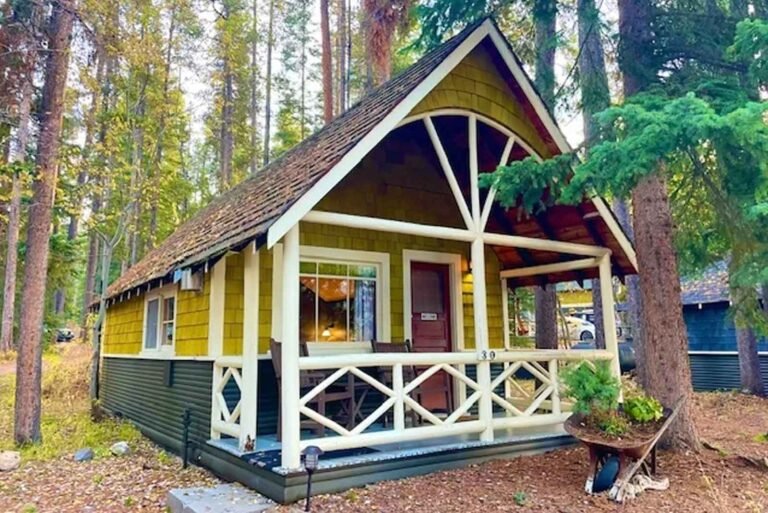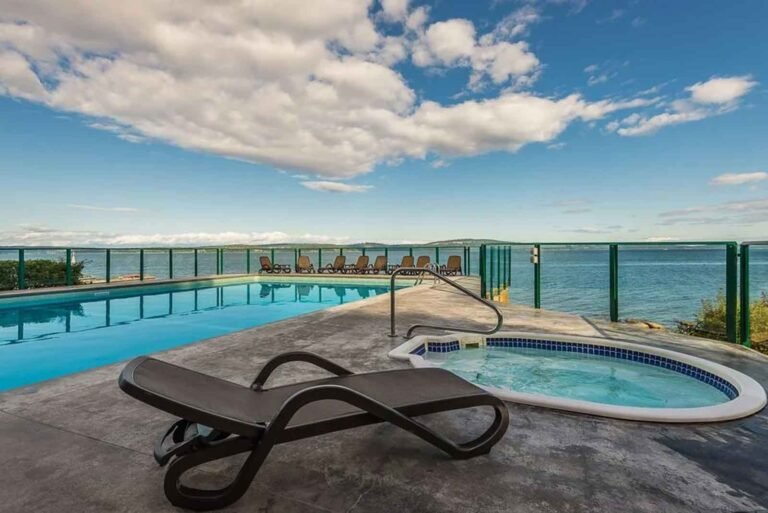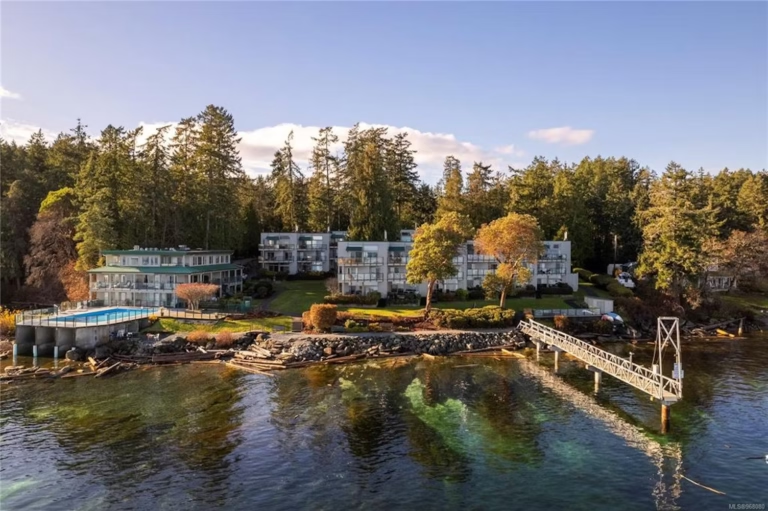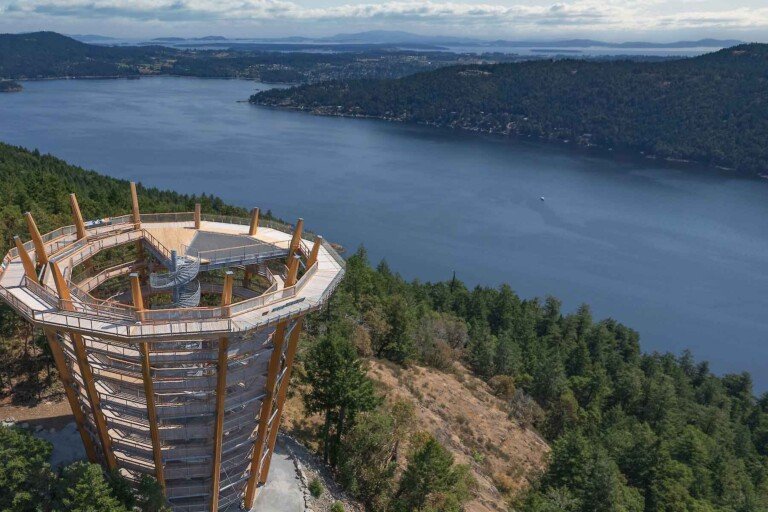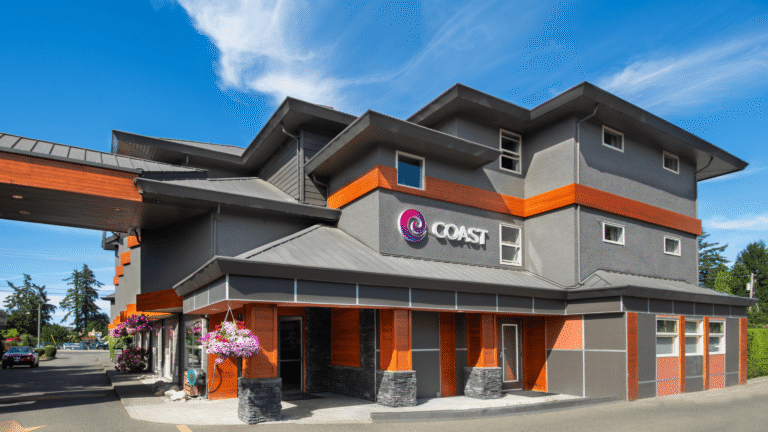The sportsman’s paradise and industry hub of Kitimat is embraced by the lush wilderness of the northwest of British Columbia, nestled in the majestic valley at the head of the Douglas Channel.
Built in the 1950s for the world’s largest aluminum smelter, the Aluminum Company of Canada (Alcan), the town of Kitimat looks like it was planned down to the very last brick … and it certainly was! The community was pre-planned, with defined residential areas and a centralized urban core.
Drawing its name from the nearby Haisla community of Kitamaat, and meaning people of the snow, Kitimat is both an inland and a coastal settlement, in that the sportfishing haven sits on an arm of the Pacific Ocean that reaches 88 miles (140 km) inland, cutting deep into the Coast Mountains.
The Haisla and Henaaksaila, closely related but distinct First Nations peoples, have inhabited this area of the coast for as long as 8,000 to 12,000 years. The oral histories of the Haisla, and anthropological studies, tell of thriving communities of up to 10,000 Haisla here in the Kitimat Valley, and between 5,000 and 10,000 Henaaksaila centred on the Kitlope River watershed, about 100 km south east of Kitimat on the Gardner Canal. The Haisla and the Henaaksaila joined together in 1947, in a special ceremony in which the matriarchs of both communities accepted and sealed the amalgamation. Kitamaat Village is now the home base for many Haisla and Henaaksaila.
The moderate climate and unique geography of the northwest offers a front-row seat to one of Canada’s last true wilderness frontiers. Hikers and campers delight in the cool forest trails and secluded campsites, beachcombers and picnickers savour the sandy beaches, and the vistas of the rugged Coast Mountains are a photographer’s dream.
Population: 9,000
Location: Kitimat is nestled among the Coastal Mountains at the mouth of the Kitimat River, at the head of the Douglas Channel. Kitimat is accessed via Highway 37, heading south off Yellowhead Highway 16 near the town of Terrace.
If history is your passion, visit the Haisla Native village. The Haisla were noted for the models and seaworthiness of their canoes. Ancient and recent events of their history are recorded on totem poles seen in Kitimat’s Centennial Park, and today’s visitor can see native carvings and the art of canoe building at the Kitamaat Village.
Big Tree: Kitimat’s 500-year-old Sitka spruce tree, growing in Radley Park, is sure to captivate you with its size, age, and beauty. The oldest Sitka spruce in BC, and registered as the largest Sitka spruce in the province, this giant is 50 metres tall and over 11 metres in circumference!
See exciting exhibitions and historical displays at the Kitimat Centennial Museum, including permanent displays of Haisla culture from the Kitimaat Village, arts and technology, and turn-of-the century settlement of the Kitimat Valley. Displays of the geology, fauna and flora of the valley include fossils of dinosaurs that roamed the valley 60 million years ago.
Enjoy spectacular close-up views of Moore Creek Falls and Humphrey Creek Falls.
Fish Hatchery: See some of the 11 million juvenile chinook, chum, coho and steelhead raised and released every year by the Kitimat River Fish Hatchery. With the ocean survival rate of salmon being around one to two percent, the hatchery needs to rear huge numbers of fish in order to maintain the local salmon runs. Tours of the hatchery are available from May through to September.
Lakelse Lake Provincial Park offers a relaxing day at the beach. Pack a picnic lunch and join in the water sports and Family Nature Programs hosted at the park. Gruchy’s Beach is a 15-minute walk through forest stands of Sitka spruce and Western Red Cedar to the wide, sandy beach. Furlong Bay has 100 campsites and full facilities, set in an old-growth forest. In the Tsimshian language, ‘lakelse’ means freshwater mussel, which is a bi-valve mollusc found in Lakelse Lake and Lakelse River.
Lakelse Lake Wetlands Provincial Park at the south end of Lakelse Lake protects significant habitat for salmon spawning, over-wintering steelhead, migratory and over-wintering waterfowl, moose winter range, and Grizzly Bear habitat. Warm water springs in the wetlands drain into Lakelse Lake. The wetlands are also an important seasonal habitat for Black Bear, Wolf, Beaver and other small furbearers. Recreation in the park includes exploring the wetlands by canoe or kayak, fishing, hiking, backcountry camping, and cross-country skiing and snowshoeing in winter.
Princess Royal Island is best known as being home to the legendary white Kermode Bear, Spirit Bear of the North Coast of British Columbia. These magnificent bears are not found anywhere else in the entire world.
Kids’ Activities: Visiting children can tour the Fire Hall, cool off in one of the two outdoor wading pools, play mini golf at the chalet, fish off the dock at one of the marinas, play in the park behind Riverlodge or relax, suntan or look for ‘treasures’ at Alcan Hospital Beach.
Try your luck at the annual Fish Derby, held over the Labour Day Weekend.
Kitlope Heritage Conservancy is the world’s largest intact coastal temperate rainforest. About a two-hour boat ride from Kitimat (Kitimaat Village), this protected backcountry park protects 800-year-old trees. The best time to visit the area is July and August. Along the way, visitors can do some fishing, visit Weewanie or Shearwater (Europa) Hot Springs, watch for whales, seals, eagles, mountain goats and bears, and view the wonderful waterfalls, tall granite cliffs, and hanging glaciers of Gardner Canal.
Foch-Gilttoyees Provincial Park and Protected Area on the north side of the Douglas Channel south of Kitimat protects rugged coastal terrain, from sea level to mountain peak. Canoeing, kayaking, wilderness camping, swimming, rock climbing, scuba diving, and wildlife viewing are possible in the park.
Gitnadoiks River Provincial Park in the heart of the Kitimat Range of the Coast Mountains between Kitimat and Highway 16 offers excellent sport fishing, with at least 13 species of fish, including Pacific Salmon. Canoeing, kayaking, wilderness camping, and wildlife viewing are possible in the park.
Fishing: Kitimat is truly a sport fishing paradise, with steelhead, chinook, chum and coho salmon all making their way up the Kitimat, not to mention the feisty resident population of cutthroat trout. The spring run of steelhead peaks in early May, and continues to the middle of the month, chinook start arriving in late May, providing anglers with memorable battles through June and the first part of July. Chum arrive in late July and August, with coho providing the fight in late August and the beginning of September. Be sure to get a copy of the tide tables, and find out what’s working at the local tackle shops. Saltwater fishing offers snappers, cod or halibut running to 120 lbs.
Hiking: Surrounded by pristine wilderness, hiking trails abound around Kitimat, whether you’re looking for a pleasant stroll through the woods or a challenging climb to the top of a mountain. Easy strolls can be enjoyed to Hirsch Creek Park and Humphrey Creek Falls, with a longer three-hour easy trail to the spectacular view at the Hirsch Creek Canyon. If alpine meadows and views over the Kitimat Valley and Douglas Channel are what you seek, then try the Clague Mountain Trail, a difficult 6-km hike with a return time of 8 to 10 hours. An even greater challenge is the steep and difficult trail that leads hikers on the 9 to 12 hour return trip to the peak of the almighty Mt. Elizabeth, at 6300m. When hiking the area with a dog, remember to pack a leash and a bear bell. A pet can anger a bear and provoke an attack.
Recreation Sites: There is a variety of recreational opportunities available in the Kitimat Valley and the Douglas Channel, with 17 recreation sites and 20 hiking trails in the area. Overnight camping is available at all recreation sites.
Mountain Biking: Welcome to mountain biking bliss – the diverse terrain is tailor-made for all levels of riders. The Onion Lakes cross-country ski trails, north of Kitimat on Hwy 37, provide great biking in the summer months, with 23 km of trails to choose from.
Hot Springs: Canoe through natural hot springs or kayak down the cascading waterfalls that embrace the Douglas Channel. There are three natural mineral hot springs in the Douglas Channel area; Weewanie, 25 km from town, Europa point, 65 km away, and Bishop Bay, 80 km out. All three feature small bath houses built by the Kitimat Yacht Club.
Golf: Kitimat offers golf at the Hirsch Creek Golf & Winter Club, a semi-private 18-hole golf course.
Golf Vacations in British Columbia.
The Kitimat River Estuary provides nesting and feeding habitat for thousands of migrating birds during the spring and autumn. No other location supports as many species or numbers of birds – more than 112 bird species, some very rare, have been recorded here. The estuary can be reached by boat or car, with May being the best time to view thousands of waterfowl and shorebirds, including Snow Geese, Cinnamon Teals, Canvasbacks, Lesser Golden Plovers, and Whimbrels.
Shames Mountain, one of North America’s “best-kept secrets”, provides unmatched powder and internationally acclaimed backcountry skiing opportunities – and fantastic cross-country skiing. The cross-country ski trails at Onion Lake, a 20-minute drive south of Terrace on Hwy 37, have both classic and skate-skiing trails suitable for all abilities. The terrain around Terrace is ideal for snowmobiling, and exercise enthusiasts wanting to get out into the crisp winter air can strap on their snowshoes and hit the outdoor trails.
Skiing & Winter Activities in the North West.
Circle Tours: See the best of Northern BC on one of the Circle Tours that capture the wonders of the north. The Circle Tour of Northern British Columbia incorporates the Alaska Highway through the Rocky Mountain foothills to Watson Lake in the Yukon, linking with the Stewart/Cassiar Highway and Yellowhead Highway 16 in the south. The Inside Passage Circle Tour and the Native Heritage Circle Tour follow the same route, from Port Hardy on Vancouver Island north by ferry to Prince Rupert. Catch another ferry to the Queen Charlotte Islands, or venture east on the Yellowhead Highway to Prince George, and south through the peaceful Cariboo to Vancouver along the historic Cariboo Wagon Road.
Circle Tours in British Columbia.


